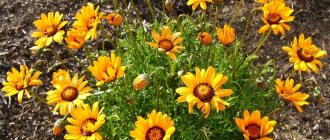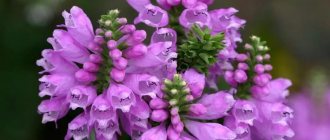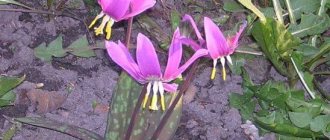Dichondra silvery waterfall, which is also known as dichondra creeping, is a member of the bindweed family and belongs to the ampelous deciduous and decorative perennial vines.
This plant is widespread in American, Australian and East Asian countries.
The main value of the plant lies in the decorative appearance of its creeping shoots, which are covered with dense foliage.
It is often used in landscape design when decorating gazebos, loggias, gardens and other objects.
Description
The name of the perennial comes from Greek and is translated as “2 grains,” which characterizes the structure of the plant’s fruits.
A creeping plant in nature can reach 6-7 m, but in the case of cultivated varieties, the maximum length of silver dichondra is 2 m. The main characteristics of the plant are as follows:
- Shoots take root easily in leaf nodes.
- The lashes form a carpet, cascading down.
- In shaded areas, dichondra silver grows more actively.
- The leaf blades are small - up to 2.5 cm, silvery, rounded.
- Flowering is represented by inconspicuous yellowish-green inflorescences, which do not increase the decorative properties of dichondra.
Dichondra has gained significant prevalence and popularity among gardeners due to its resistance to pests and diseases, as well as ease of care, relative unpretentiousness to growing conditions and high decorative properties.
How to grow a crop from seed
The plant is an annual. It can only grow for one summer. If there is no crop at your summer cottage, you can grow it by planting cuttings. In this case, dichondra takes root in the summer. You can also transplant the shoot that was obtained by tapping.
Planting dichondra seeds
When using the generative (seed) method, sowing seeds should be done in two ways. Firstly, seed material is poured directly into the soil at the summer cottage. But in this case, the seedlings may not please you with their beauty and originality. It is better to sow seedlings in mid-winter. Even seedlings planted at the end of winter will delight you with their beauty.
Growing dichondra from seeds begins with preparing planting material. Pour water into a container, add a little product to stimulate rapid growth, and mix the solution thoroughly. The water should be at room temperature. Then pour the planting material suitable for planting into the prepared water, spreading it over the bottom. Leave overnight.
Preparing soil mixture for seedlings
For planting, prepare a mixture by mixing peat and sand in equal parts. You can take a ready-made mixture for flower crops. The prepared mixture should be kept in the cold for two days, and then brought into the room and left for a day.
Pour the prepared mixture into a container and place in an oven preheated to 100 degrees. Here the pots should stand for 3-4 hours. This is necessary to disinfect the soil. Then take sodium humate and spill it on the ground. Plant the prepared planting material into the soil, deepening it to 8 mm. It is better to take small pots for planting.
After planting, the soil is thoroughly watered with warm water. Place glass or film on the pot. But you must not forget about ventilation, since the planting material must breathe. Then the pots are placed on the windowsill, covering the window a little with paper, since the light should be diffused. For better plant germination, it is recommended to illuminate the ground. The air temperature should exceed 20 degrees.
The most common plant varieties
More than 10 varieties of dichondra can grow in Russia, however, only 2 are the most popular - “Silver Falls” and “Emerald Falls”. Dichondra silver is characterized by the following features:
- forms a dense carpet on the surface;
- foliage is gray-silver;
- prefers illuminated and moderately illuminated areas;
- stems creeping, long.
Dichondra “Emerald Falls” is characterized by virtually the same parameters, with the exception of the color of the foliage - it is not silver-gray, but a rich emerald green color.
Another difference is that "Emerald Falls" is a shade-loving plant, unlike "Silver".
Silver waterfall under the sun
Emerald waterfall on the wall
The prefix “waterfall” was given because each stem of the plant has a certain resemblance to a stream of water falling down.
Growing seedlings
It is possible to obtain plant seedlings in 2 ways - by cuttings and by sprouting seeds. The simplest option is to grow a new plant from a cutting.
This requires 5-7 blanks, which are rooted in a glass of water. Roots form quickly enough, which allows plants to be transplanted into containers with soil mixture in the shortest possible time.
For reference!
Plants obtained by cuttings grow quite quickly and form a lush and dense crown.
There is an option for growing silver dichondra from seeds at home. Sowing of seed material must be done from the end of January to the beginning of spring.
With this option for growing dichondra silver waterfall, the plant becomes mature in 4 months and can be transplanted into open ground or placed outdoors in a container.
To grow dichondra silver waterfall, you need to perform the following manipulations:
- Seedling containers are filled with a soil mixture consisting of soil and sand in proportions of 1 to 1.
- The seed material is planted 0.5 cm deep and sprinkled with sand on top.
- The surface of the sand is moistened with a spray bottle and the container is covered with glass or cling film.
- In the room with seedling containers, the temperature should be maintained around 25 °C.
- Direct sunlight should not be allowed to fall on the container to prevent the creation of a greenhouse effect, since in this case the seeds will overheat, which will render them unusable.
- The first sunrises appear after 10-14 days.
- After the first seedlings appear, you need to remove the film or glass and place the seedling container in a lighted area.
- After the first 3-4 true leaves have appeared, the seedlings need picking.
It is possible to plant 3-4 sprouts at a time in pots or hanging baskets.
In this embodiment, they are located on closed loggias or balconies. It is possible to transfer silver waterfall dichondra to open ground or open air only after 4 months from the moment the seedlings appear.
Planting a plant on the site
Dichondra prefers a humid and warm climate, so it grows in natural conditions in New Zealand, America, and Australia. It often settles in swampy areas.
Growing dichondra in Russian conditions is also possible, as evidenced by photos taken by summer residents on their plots. Any soil is suitable for planting, but it is best to choose loose, well-drained soil. Fertile soil will allow dichondra to form beautiful, large leaves.
Attention! In cold regions, the vine is usually grown as an annual because it does not overwinter in open ground. You can plant dichondra in flowerpots and bring them into your apartment for the winter.
The illumination of the area is determined by the variety you have chosen. In any case, strong shade is not suitable for planting and propagating vines. In such conditions, even with good care, the culture will develop poorly. Planting dates depend on the region in which you live: for the south it will be May, for the middle part of the Russian Federation - late spring or early summer. The last time residents of the northern regions plant dichondra in open ground is in June. You can root cuttings prepared in the fall or seedlings.
Growing and care
When growing dichondra silver waterfall, it is necessary to follow certain agrotechnical measures, which involve the following actions and compliance with the following conditions by the grower:
Watering must be regular, since dichondra silver waterfall is a moisture-loving plant. Moistening the soil should be done immediately after the top soil layer dries out. However, you need to beware of overwatering, as this may cause rotting of the root system. Watering should be done in the morning or evening hours - before or after sunset. If drops of water get on the foliage during the day, Dichondra silver waterfall can get sunburn.
Air humidity - dichondra silver waterfall requires not only watering, but also timely spraying, when the thermometer increases to 26-30 ̊C. Also, such a need is determined by the fact that, having sufficiently long shoots, dichondra is not able to provide itself with a sufficient volume of liquid, subject to exclusively root watering. Regular spraying leads to an increase in green mass of the plant.
Pruning - allows you to achieve a lush crown of a beautiful shape. To do this, in the autumn, all branches are shortened by 10-15 cm - to ensure more active branching of the plant in the spring. During the growing season, the apical stems must be periodically shortened, and those stems that are damaged or out of shape are cut off.
Feeding is an important component of care. If there is a lack of nutrients, the plant loses its green mass, the crown becomes sparse and there are no flowers. Silver waterfall dichondra needs to be fed every week, and it is necessary to alternate potassium-phosphorus and nitrogen fertilizers.
Planting in open ground
Dichondra is a tropical plant by origin that is accustomed to warmth.
Therefore, planting “Silver Falls” in open ground or moving containers into the open air is possible only after the outside temperature reaches 16-18 ̊C.
While there is a possibility of night frosts, it is not advisable to keep the plant outdoors. But, pots and baskets with decorative deciduous perennials can be hung outside during the daytime to enhance their growth.
Dichondra silver waterfall is suitable for virtually any soil mixture, but the most outstanding results can be achieved when using loamy, well-drained soil.
But the plant cannot tolerate stagnation of liquid - its rhizomes begin to rot.
One of the key points in growing the described perennial is sufficient illumination.
If there is a lack of sunlight, the branches of the silver waterfall dichondra stretch out, the foliage becomes sparser, the stems become exposed and the plant loses its own decorative qualities. Also, in shaded areas this plant does not actually bloom.
Important!
Only the silver waterfall dichondra requires sunny areas; in the case of the emerald variety, shaded areas are needed.
Before planting silver waterfall dichondra in open ground, the seedlings need to be hardened off.
To do this, the perennial is taken out into the open air for 1-2 weeks, and the time the plant stays outside gradually increases.
Before planting, you need to carefully dig up the area of soil, remove all old rhizomes and possible weeds from it.
The planting scheme depends on the purpose of the plant. In cases where an ornamental deciduous perennial is grown as ground cover, the gaps between individual plants should be about 15-20 cm.
When dichondra silver waterfall is combined with other vegetation, the distance between individual shoots increases and amounts to 30-40 cm.
Seedlings must be placed in holes, the depth of which is no more than 3 cm - the root system must fit completely into the soil. After planting around the perennial, the earth is slightly compacted and moistened.
Care during the winter season
Perennials that grow in containers are brought indoors during the cold season, and their shoots are first pruned.
After winter is over and the threat of night frosts has disappeared, containers with dichondra can again be taken out into the open air.
When growing dichondra in open ground, in the autumn with the first frosts, the plants are uprooted, and new specimens are planted in their place as the weather warms up.
But, there is an option to preserve the uterine rhizome in the underground. In this case, the grower needs to perform the following procedure:
- All shoots of Dichondra silver waterfall are cut off.
- The root system of the plant is dug out of the soil.
- The rhizome is sprinkled with sand and sent to the cellar or basement for storage.
- In March, sprouts appear on the root system, the plant is removed and planted in containers.
- When the street temperature remains stable at 16 °C or more, the decorative deciduous perennial is transplanted into open ground.
If all agrotechnical requirements are met, silver waterfall dichondra can grow for 6-7 years.
When a perennial begins to age, it can be used as a source of cuttings, from which a significant number of young dichondria immediately grow in a short period of time.
Planting dichondra in open ground
What time to plant
In regions with warm and mild climates, dichondra is used to create an alternative lawn. This is possible due to the fact that it is resistant to frost and also to trampling. The ampelous dichondra is transplanted into the garden only after 1.5–2 months have passed after the seedlings appear. In the northern regions, dichondra seedlings are planted around the first half of June, and in the southern regions - in May. This flower grows well in sunny areas and in shade. But it should be taken into account that the variety with silver foliage is more light-loving. Dichondra does not have any special requirements for soil composition, but it grows best in well-drained loamy soil with a pH of 6.6–8.0.
Landing rules
If you plan to grow dichondra as a ground cover plant, then you need to remember that it is characterized by extremely slow growth. That is why, when planting in the ground, a distance of 10 to 15 centimeters must be maintained between the bushes. The depth of the planting holes should be such that the root system of the plant, taken together with a lump of earth, can be placed in them. Carefully transfer the seedlings into the holes and fill them with soil, compact its surface and water generously.
Pests and diseases
Decorative deciduous perennials are often attacked by the following pests:
- whitefly;
- aphids;
- fleas.
To protect the plant, it is advisable to periodically treat dichondra with any insecticide.
For this purpose, it is possible to use the following specialized drugs:
- Aktara;
- Aktellik;
- Spark.
Whitefly on a leaf
The disease can develop in case of excessive soil moisture.
This is often observed in the case of groundcover growth of perennials.
The shoots cover the ground quite tightly, which leads to a virtual lack of aeration of the roots.
In case of signs of disease, the intensity of watering must be reduced.











